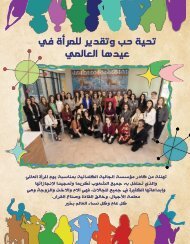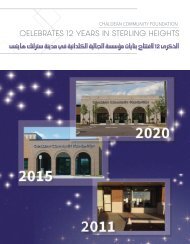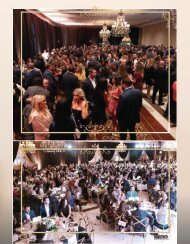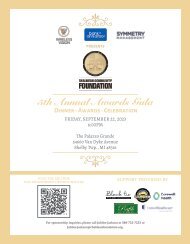Create successful ePaper yourself
Turn your PDF publications into a flip-book with our unique Google optimized e-Paper software.
an Adventist hospital here) but each<br />
had its own difficulties.<br />
AI-Hikma can serve as the basis<br />
of our putting the university under<br />
the patronage of the Spirit of Wisdom<br />
or of Our Lady, Seat of Wisdom.<br />
It had these religious associations for<br />
us and yet for the Muslim it is still<br />
appropriate for a center of learning.”<br />
When AI-Hikma began operating<br />
in September 1956, its total<br />
(freshman) enrollment was 45; within<br />
eight short years the enrollment<br />
had grown to 530. By the time the<br />
Jesuits were expelled, the enrollment<br />
had grown to 656. The student enrollment<br />
steadily increased, but the<br />
number of Jesuits actively engaged in<br />
administration and teaching did not<br />
grow as rapidly.<br />
In November 1957, ground was<br />
broken at Za’afarania for the first<br />
building. By September 1959, the<br />
Engineering and Business buildings<br />
were completed. During AI-Hikma’s<br />
first three years at Sulaikh, the Jesuit<br />
architect, Fr. Leo Guay, was busy<br />
with the construction of the buildings<br />
which he had designed for the<br />
permanent Za’afarania campus. In<br />
the summer of 1958, the historic<br />
July 14 Revolution toppled the monarchy,<br />
and Iraq became a republic.<br />
Anxious days followed. The country<br />
underwent sudden and violent<br />
changes.<br />
Building AI-Hikma went serenely<br />
on, and Fr. Guay quietly continued<br />
his construction work, so that<br />
by 1959 the campus moved from<br />
Sulaikh to Za’afarania. For nearly a<br />
year, the pioneering Jesuit community<br />
occupied interim quarters on the<br />
second floor of the Business Building,<br />
temporarily slept in classrooms, ate<br />
their meals in an unfinished laboratory,<br />
and depended on solar heating<br />
for their hot water. The following<br />
year they finally settled down in the<br />
spacious residence, Spellman Hall,<br />
designed and built by Fr. Guay.<br />
This new campus, with assistance<br />
from Fr. Loeffler and his Iraqi gardeners,<br />
became one of the most attractive<br />
sights in the city. The enrollment,<br />
slow in the beginning, made<br />
rapid strides, and the facilities were<br />
taxed to the limit. As in Baghdad<br />
College, the athletic program and<br />
the wide and varied offering of activities<br />
made for a pleasant and relaxed<br />
atmosphere. AI-Hikma alumni who<br />
entered business or pursued graduate<br />
studies testified to the academic excellence<br />
of the university.<br />
At the Za’afarania campus the<br />
College of Engineering Al Hikma University 1965<br />
first graduation was held in June<br />
1960. Major General Abdul Karim<br />
Qasim, the Prime Minister of the<br />
Republic, delivered a talk and presented<br />
the diplomas. More than<br />
1000 people attended; among those<br />
present were the chief officers of the<br />
new revolutionary government and<br />
members of the Diplomatic Corps.<br />
AI-Hikma quickly attained a<br />
certain academic, moral, and social<br />
stature which made it a positive influence<br />
for good in many ways. It<br />
enjoyed a high reputation in both<br />
governmental and non-governmental<br />
circles, for academic excellence,<br />
integrity, and service. If this were<br />
not so, AI-Hikma would not have<br />
survived the situation which resulted<br />
from the June 1967 war between Israel<br />
and the Arab states. At that time<br />
emotions ran high, and a singularly<br />
bitter wave of anti-American feeling<br />
swept the Arab world and filled the<br />
Arab media.<br />
In response to American support<br />
of Israel, AI-Hikma became the special<br />
object of attack by certain “concerned”<br />
writers in some Baghdad<br />
Arabic newspapers, and was alleged<br />
to be an enemy of the Arabs, a nest<br />
of spies and agents of the CIA.<br />
The Iraqi government was called<br />
upon to take over AI-Hikma and<br />
Baghdad College. Throughout that<br />
anxious summer AI-Hikma benefited<br />
from the support and encouragement<br />
of many responsible Iraqis, in official<br />
as well as unofficial quarters. Applicants<br />
for registration were as numerous<br />
as ever, in fact AI-Hikma began<br />
the 1967 academic year with a substantial<br />
enrollment increase with 66<br />
students over the previous year.<br />
The expulsion<br />
Ignatian education, which began in<br />
1547, is committed to the service<br />
of faith, of which the promotion of<br />
justice is an absolute requirement.<br />
Because of this, both Jesuit and lay<br />
educators in Jesuit schools have<br />
been a thorn in the side of tyrants<br />
for more than four centuries. Jesuits<br />
were often dismissed from countries<br />
and frequently involved in awesome<br />
controversies.<br />
Such is the skeleton history of the<br />
Jesuits in Baghdad. They were not<br />
missionaries in the classical sense of<br />
the term, and they rarely preached<br />
at all. Baghdad was referred to by<br />
some as a fruitless waste of men and<br />
money; others called it a mission of<br />
faith to underline the lack of concrete<br />
consolations and accomplishments.<br />
But these were the judgments<br />
of “outsiders,” people who had not<br />
experienced the myriad fascinations<br />
of Baghdad and Baghdadis. They had<br />
no knowledge of the impact Jesuits<br />
made on students as well as their<br />
families, Muslim as well as Christian.<br />
Jesuits also impacted Baghdad<br />
society. The opportunities provided<br />
to make contributions in education<br />
were many and the response of the<br />
Jesuits was praiseworthy. The development<br />
of an English program especially<br />
geared to Arabic speaking students<br />
was one instance; a course in<br />
religion tailored to Iraqi Christians<br />
was another.<br />
Most fascinating was the case of<br />
Fr. Guay, who turned his side interest<br />
in architecture to a full-time occupation.<br />
He designed and executed<br />
the construction of most of the<br />
buildings on campus. The two Jesuit<br />
campuses were designed as low cost,<br />
functional architecture reflecting the<br />
periods of Iraqi history from Babylon<br />
up through the Muslim period. The<br />
Jesuit impact certainly went beyond<br />
the walls of the two schools.<br />
It is hard for a foreigner to blend<br />
fully into a different culture, but<br />
the attempt was made and was appreciated.<br />
Fr. Richard McCarthy<br />
became one of the well-known Arabic<br />
preachers in the Christian community<br />
and established a reputation<br />
for his education in Muslim theology<br />
among the learned men in Iraq.<br />
Perhaps it can all be summed up<br />
by the fact that the Iraqis are a happy<br />
and hospitable people, frank, warm,<br />
and forthright in expressing appreciation<br />
as well as disapproval.<br />
The Jesuits had overcome, in<br />
part, their foreign origin and had<br />
identified with the church in Iraq<br />
and with the Iraqi educational system.<br />
However, there was always the<br />
awareness that at any time the Jesuits<br />
might be asked to leave as they were<br />
guests of the Iraqi government. Each<br />
year they had to renew their permits<br />
for residence in Iraq, and every wave<br />
of anti-American feeling which blew<br />
across the Middle East was a threat to<br />
CULTURE continued on page 34

















